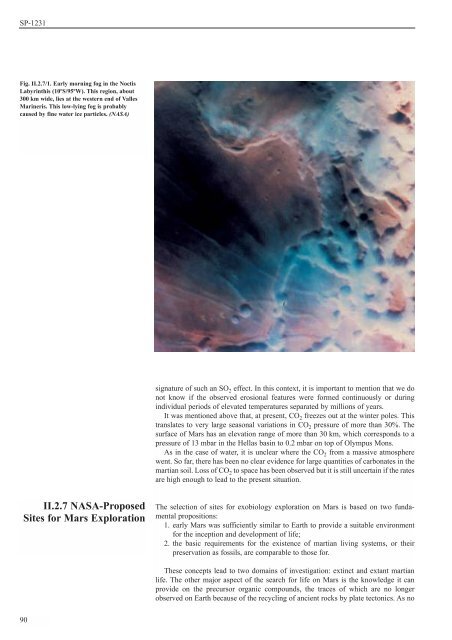Exobiology in the Solar System & The Search for Life on Mars - ESA
Exobiology in the Solar System & The Search for Life on Mars - ESA
Exobiology in the Solar System & The Search for Life on Mars - ESA
Create successful ePaper yourself
Turn your PDF publications into a flip-book with our unique Google optimized e-Paper software.
SP-1231<br />
Fig. II.2.7/1. Early morn<str<strong>on</strong>g>in</str<strong>on</strong>g>g fog <str<strong>on</strong>g>in</str<strong>on</strong>g> <str<strong>on</strong>g>the</str<strong>on</strong>g> Noctis<br />
Labyr<str<strong>on</strong>g>in</str<strong>on</strong>g>this (10ºS/95ºW). This regi<strong>on</strong>, about<br />
300 km wide, lies at <str<strong>on</strong>g>the</str<strong>on</strong>g> western end of Valles<br />
Mar<str<strong>on</strong>g>in</str<strong>on</strong>g>eris. This low-ly<str<strong>on</strong>g>in</str<strong>on</strong>g>g fog is probably<br />
caused by f<str<strong>on</strong>g>in</str<strong>on</strong>g>e water ice particles. (NASA)<br />
II.2.7 NASA-Proposed<br />
Sites <str<strong>on</strong>g>for</str<strong>on</strong>g> <strong>Mars</strong> Explorati<strong>on</strong><br />
90<br />
signature of such an SO 2 effect. In this c<strong>on</strong>text, it is important to menti<strong>on</strong> that we do<br />
not know if <str<strong>on</strong>g>the</str<strong>on</strong>g> observed erosi<strong>on</strong>al features were <str<strong>on</strong>g>for</str<strong>on</strong>g>med c<strong>on</strong>t<str<strong>on</strong>g>in</str<strong>on</strong>g>uously or dur<str<strong>on</strong>g>in</str<strong>on</strong>g>g<br />
<str<strong>on</strong>g>in</str<strong>on</strong>g>dividual periods of elevated temperatures separated by milli<strong>on</strong>s of years.<br />
It was menti<strong>on</strong>ed above that, at present, CO 2 freezes out at <str<strong>on</strong>g>the</str<strong>on</strong>g> w<str<strong>on</strong>g>in</str<strong>on</strong>g>ter poles. This<br />
translates to very large seas<strong>on</strong>al variati<strong>on</strong>s <str<strong>on</strong>g>in</str<strong>on</strong>g> CO 2 pressure of more than 30%. <str<strong>on</strong>g>The</str<strong>on</strong>g><br />
surface of <strong>Mars</strong> has an elevati<strong>on</strong> range of more than 30 km, which corresp<strong>on</strong>ds to a<br />
pressure of 13 mbar <str<strong>on</strong>g>in</str<strong>on</strong>g> <str<strong>on</strong>g>the</str<strong>on</strong>g> Hellas bas<str<strong>on</strong>g>in</str<strong>on</strong>g> to 0.2 mbar <strong>on</strong> top of Olympus M<strong>on</strong>s.<br />
As <str<strong>on</strong>g>in</str<strong>on</strong>g> <str<strong>on</strong>g>the</str<strong>on</strong>g> case of water, it is unclear where <str<strong>on</strong>g>the</str<strong>on</strong>g> CO 2 from a massive atmosphere<br />
went. So far, <str<strong>on</strong>g>the</str<strong>on</strong>g>re has been no clear evidence <str<strong>on</strong>g>for</str<strong>on</strong>g> large quantities of carb<strong>on</strong>ates <str<strong>on</strong>g>in</str<strong>on</strong>g> <str<strong>on</strong>g>the</str<strong>on</strong>g><br />
martian soil. Loss of CO 2 to space has been observed but it is still uncerta<str<strong>on</strong>g>in</str<strong>on</strong>g> if <str<strong>on</strong>g>the</str<strong>on</strong>g> rates<br />
are high enough to lead to <str<strong>on</strong>g>the</str<strong>on</strong>g> present situati<strong>on</strong>.<br />
<str<strong>on</strong>g>The</str<strong>on</strong>g> selecti<strong>on</strong> of sites <str<strong>on</strong>g>for</str<strong>on</strong>g> exobiology explorati<strong>on</strong> <strong>on</strong> <strong>Mars</strong> is based <strong>on</strong> two fundamental<br />
propositi<strong>on</strong>s:<br />
1. early <strong>Mars</strong> was sufficiently similar to Earth to provide a suitable envir<strong>on</strong>ment<br />
<str<strong>on</strong>g>for</str<strong>on</strong>g> <str<strong>on</strong>g>the</str<strong>on</strong>g> <str<strong>on</strong>g>in</str<strong>on</strong>g>cepti<strong>on</strong> and development of life;<br />
2. <str<strong>on</strong>g>the</str<strong>on</strong>g> basic requirements <str<strong>on</strong>g>for</str<strong>on</strong>g> <str<strong>on</strong>g>the</str<strong>on</strong>g> existence of martian liv<str<strong>on</strong>g>in</str<strong>on</strong>g>g systems, or <str<strong>on</strong>g>the</str<strong>on</strong>g>ir<br />
preservati<strong>on</strong> as fossils, are comparable to those <str<strong>on</strong>g>for</str<strong>on</strong>g>.<br />
<str<strong>on</strong>g>The</str<strong>on</strong>g>se c<strong>on</strong>cepts lead to two doma<str<strong>on</strong>g>in</str<strong>on</strong>g>s of <str<strong>on</strong>g>in</str<strong>on</strong>g>vestigati<strong>on</strong>: ext<str<strong>on</strong>g>in</str<strong>on</strong>g>ct and extant martian<br />
life. <str<strong>on</strong>g>The</str<strong>on</strong>g> o<str<strong>on</strong>g>the</str<strong>on</strong>g>r major aspect of <str<strong>on</strong>g>the</str<strong>on</strong>g> search <str<strong>on</strong>g>for</str<strong>on</strong>g> life <strong>on</strong> <strong>Mars</strong> is <str<strong>on</strong>g>the</str<strong>on</strong>g> knowledge it can<br />
provide <strong>on</strong> <str<strong>on</strong>g>the</str<strong>on</strong>g> precursor organic compounds, <str<strong>on</strong>g>the</str<strong>on</strong>g> traces of which are no l<strong>on</strong>ger<br />
observed <strong>on</strong> Earth because of <str<strong>on</strong>g>the</str<strong>on</strong>g> recycl<str<strong>on</strong>g>in</str<strong>on</strong>g>g of ancient rocks by plate tect<strong>on</strong>ics. As no

















